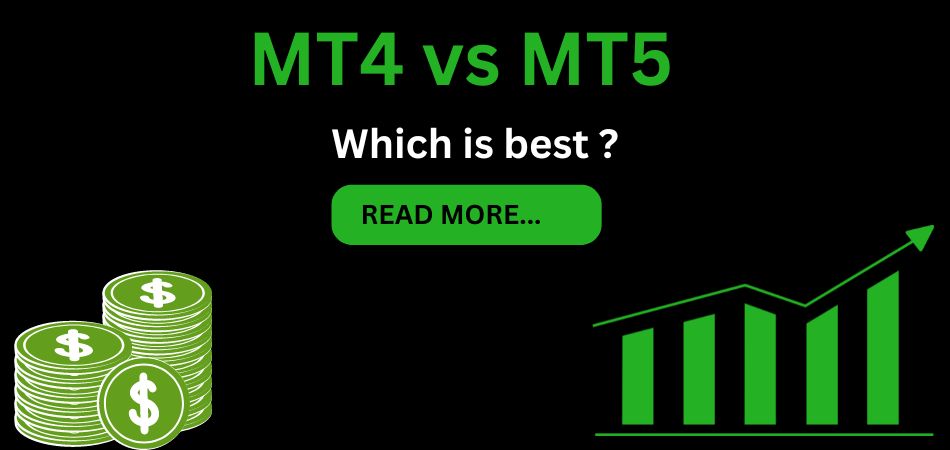MT4 vs MT5: Which Forex Trading Platform is Right for You?

Stocks to Buy Today: A Comprehensive Guide
September 16, 2024
Best Forex Trading Platforms for 2024
September 18, 2024Introduction
Choosing the right trading platform is one of the most critical decisions a trader can make. MetaTrader 4 (MT4) and MetaTrader 5 (MT5) are two of the most popular platforms globally, but understanding their differences is essential for making an informed choice. In this article, we’ll dive deep into the features, pros, and cons of both(mt4 vs mt5) platforms to help you decide which one fits your trading style.
Table of Contents
Overview of MetaTrader 4 (MT4)
History of MT4
MetaTrader 4, developed by MetaQuotes in 2005, quickly became the go-to platform for forex traders. Its primary focus is on forex trading, and it offers a simple yet powerful interface that has earned the trust of millions of users globally.
Key Features of MT4
- Forex-focused: MT4 is designed primarily for forex traders, making it highly specialized.
- Custom Indicators: Traders can create or use a variety of custom indicators.
- Expert Advisors (EAs): Automated trading tools allow traders to execute strategies without manual intervention.
- Comprehensive charting: Includes numerous charting tools and technical indicators.
Overview of MetaTrader 5 (MT5)
History of MT5
MetaTrader 5 was released by MetaQuotes in 2010 as a more advanced version of MT4, designed to accommodate trading across multiple financial markets, including stocks, commodities, and futures.
Key Features of MT5
- Multi-asset support: Unlike MT4, MT5 allows trading in various financial instruments beyond forex.
- Advanced charting tools: Includes more timeframes, more order types, and better analytical tools.
- Economic calendar: Built-in feature providing real-time news and market updates.
- Depth of Market (DOM): Offers deeper insights into market liquidity.
Differences Between MT4 vs MT5
Trading Instruments
MT4 primarily focuses on forex, while MT5 offers trading in a wider range of assets, including stocks, commodities, and futures.
Timeframes and Charting Tools
MT5 offers 21 timeframes compared to MT4’s 9. MT5 also has more advanced charting options, making it suitable for traders who rely heavily on technical analysis.
Order Types and Execution Models
MT5 provides more types of pending orders (six versus MT4’s four), giving traders greater flexibility in order execution. MT5 also has better support for exchange-traded assets.
Programming Languages and EAs
MT4 uses MQL4, while MT5 uses MQL5, a more efficient and faster programming language. MT5 also offers more robust support for automated trading strategies.
Advantages of Using MT4
Simplicity and User-Friendly Interface
MT4’s interface is easier to navigate, making it ideal for beginners. Its focus on forex trading also reduces distractions for forex-specific traders.
Popularity and Extensive Community Support
MT4 has been around longer, with a larger user base and an extensive library of custom indicators and EAs.
Advantages of Using MT5
Advanced Analytical Tools
MT5 offers more indicators, charting tools, and 21 timeframes, making it perfect for traders who prefer a detailed analysis.
Faster Execution Speed
MT5 is built to handle more data and process trades faster than MT4, making it ideal for high-frequency trading and complex strategies.
Who Should Use MT4?
Beginners and Forex-Only Traders
If you’re just starting out and only plan to trade forex, MT4’s simple interface and focus make it the perfect platform for you.
Custom Indicator Lovers
With a huge variety of custom indicators available, MT4 is great for traders who like to experiment with different strategies.
Who Should Use MT5?
Professional Traders and Multi-Asset Traders
If you trade a variety of financial instruments, MT5’s multi-asset support and advanced tools will better meet your needs.
Algorithmic Traders
MT5’s superior algorithmic trading capabilities, thanks to MQL5, make it the preferred platform for automated and high-frequency traders.
Compatibility and System Requirements
Device Compatibility (Desktop, Web, Mobile)
Both MT4 and MT5 are available on desktop, web, and mobile, but MT5’s web and mobile versions are slightly more advanced.
Operating Systems and Hardware Needs
MT5 requires a bit more processing power than MT4, so traders with older computers may find MT4 more suitable.
Brokers That Offer MT4 and MT5
Top MT4 Brokers
Popular MT4 brokers include IG, XM, and OANDA.
Top MT5 Brokers
Top MT5 brokers include Admiral Markets, FP Markets, and Pepperstone.
Which Platform Has More Flexibility?
Trading Flexibility with MT4
MT4 is highly flexible for forex traders, especially for those who use custom indicators and EAs.
Multi-Asset Flexibility with MT5
MT5 offers more flexibility for traders interested in diverse markets like stocks and commodities.
Cost and Licensing
Licensing Costs for Brokers
Brokers need to pay a licensing fee to offer MT4 and MT5, but MT5 tends to be more expensive due to its advanced features.
User Costs
For most traders, both platforms are free, as costs are typically absorbed by the broker.
Transitioning from MT4 to MT5
Is it Worth Switching?
If you plan to expand into multi-asset trading or need advanced tools, switching to MT5 could be beneficial. However, if you’re happy with forex trading on MT4, the transition may not be necessary.
How to Make the Transition Smooth
Start by familiarizing yourself with MT5’s interface using a demo account. This will help ease the transition from MT4.
Future of MetaTrader Platforms
Updates and Support
While MT4 is still widely used, MetaQuotes is focusing more on updates and support for MT5.
Market Trends
As the financial markets evolve, MT5’s multi-asset capabilities will likely make it more popular in the future.
Conclusion
In summary, MT4 remains an excellent choice for beginners and forex traders who value simplicity, while MT5 is the platform of choice for more advanced traders looking to diversify their trading assets. Whether you stick with MT4 or switch to MT5 depends on your trading style and long-term goals.
FAQs
- What are the main differences between MT4 and MT5?
MT4 focuses on forex trading, while MT5 supports multiple asset classes and has more advanced features. - Can I use both MT4 and MT5 at the same time?
Yes, you can have both platforms installed and use them simultaneously. - Is MT5 better for algorithmic trading than MT4?
Yes, MT5 offers more powerful tools for algorithmic trading, making it better for this purpose. - Will MT4 continue to be supported in the future?
While MT4 is still widely used, updates and support are becoming more focused on MT5. - How do I decide which platform to use as a beginner?
Beginners who only trade forex should consider starting with MT4, while those interested in trading multiple assets may prefer MT5.


